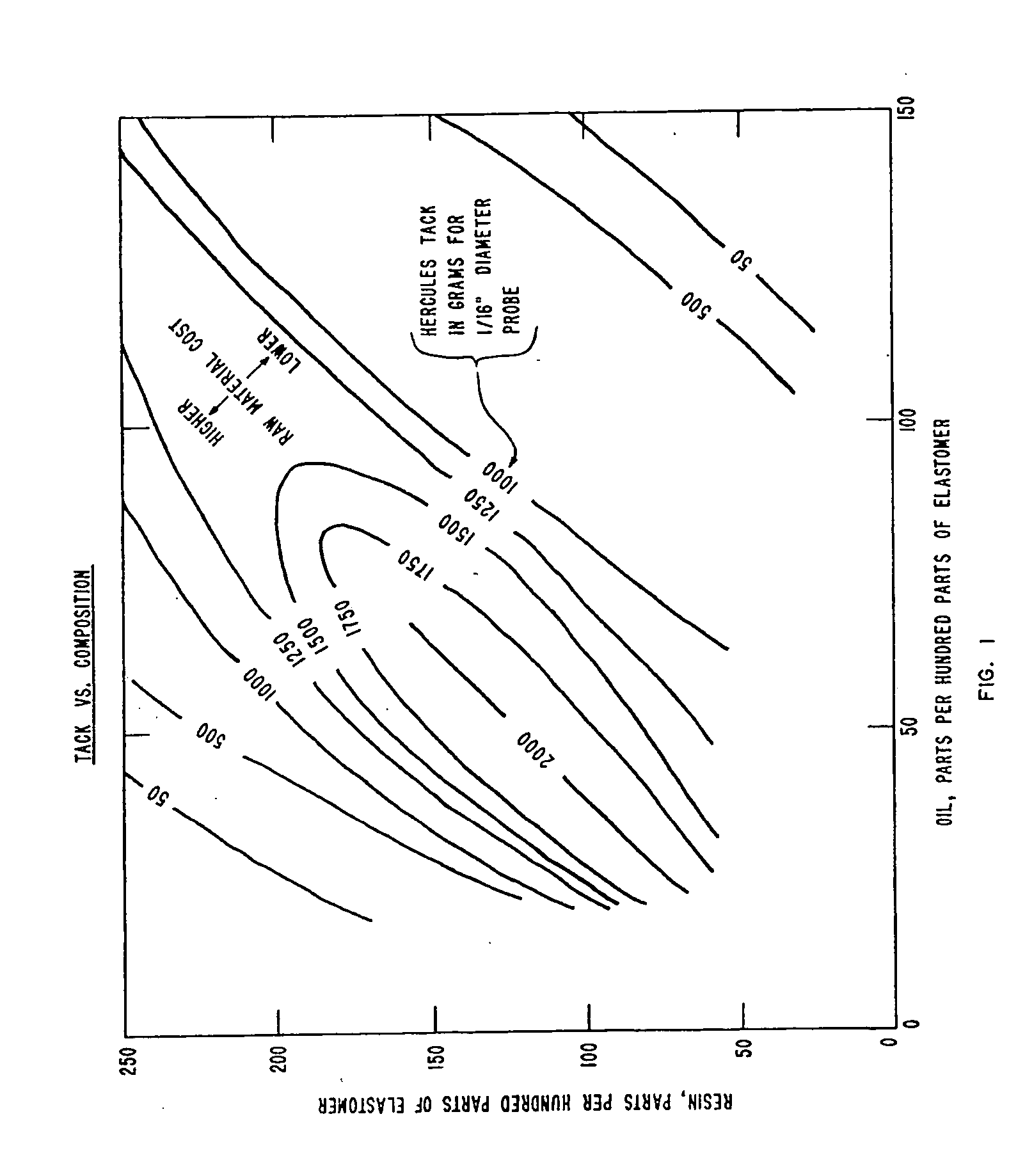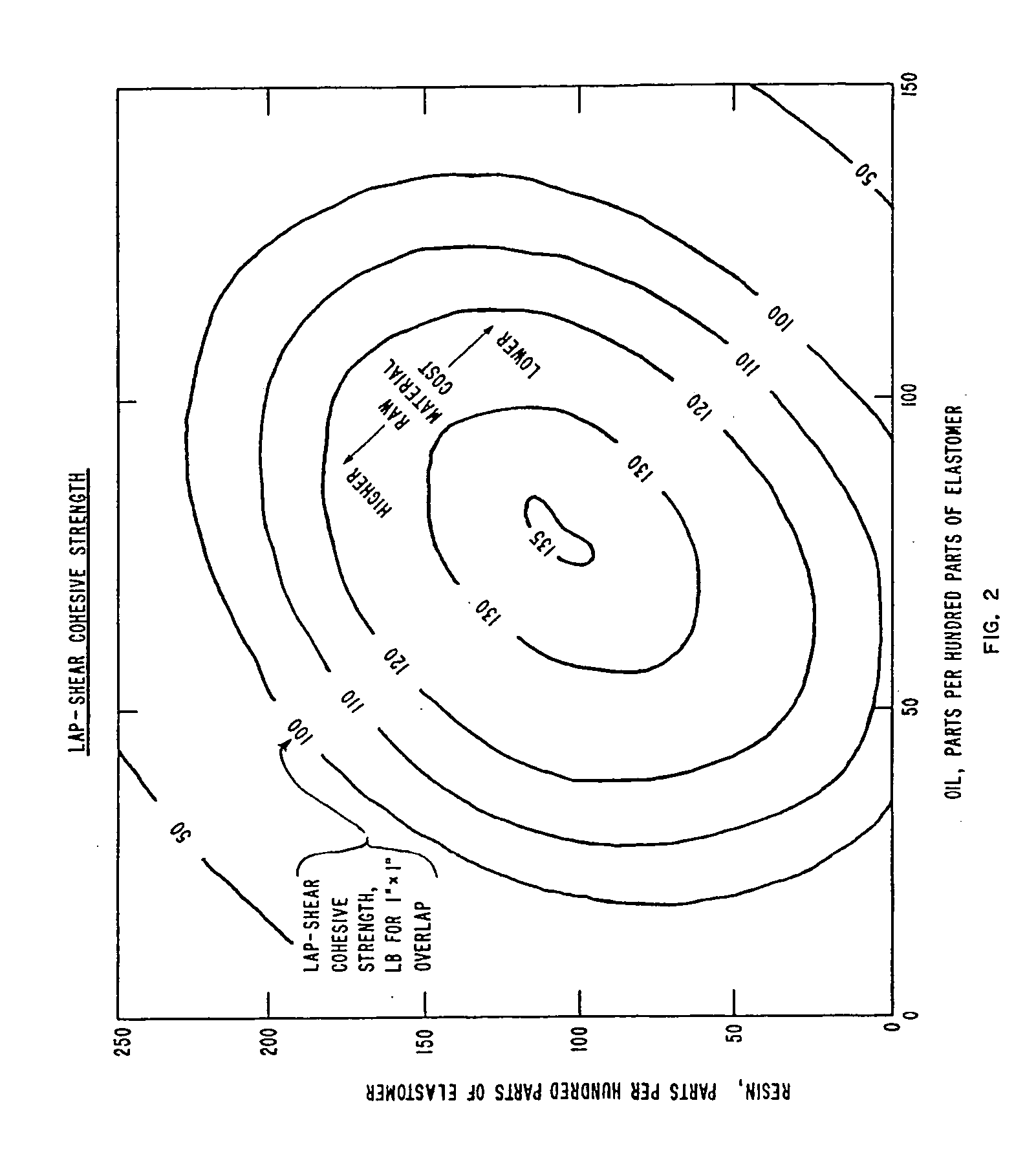Solvent based, elastomeric coatings with lower VOC
a technology of elastomeric coatings and solvents, applied in the direction of coatings, etc., can solve the problem of limited use of solvent-based coatings
- Summary
- Abstract
- Description
- Claims
- Application Information
AI Technical Summary
Benefits of technology
Problems solved by technology
Method used
Image
Examples
example 1
[0029] It would seem that, by using VOC exempt solvents, a formulator should be able to make a solvent based coating having zero VOC. This is not the case, however, because many commercial hydrogenated styrene butadiene block copolymers are not soluble in the VOC exempt solvents. This is shown by the data in Table 2 which gives the Brookfield viscosity at 25° C. of SBC #1 at 20% w in these solvents. Results show that SBC #1 will not dissolve in heptane. Heptane is a good solvent for the rubber segment of the polymer but it does not dissolve the polystyrene endblocks of the polymer. So the polymer merely swells in heptane to give a clear, soft gel. Polar solvents, such as acetone, PCBTF and tBAc are good solvents for polystyrene but not for the rubber phase of the polymer. Therefore, it is expected that SBC #1 will dissolve in blends of heptane with a polar solvent because heptane will dissolve the rubber segment and the polar solvent will dissolve the polystyrene segments of the pol...
example 2
[0031] A good candidate for making elastomeric coatings is SBC #1 using a blend of heptane and tBAc (assuming tBAc is declared to be VOC exempt). Table 3 shows potential approaches to a clear coating having a balance of VOC and viscosity with this system. A formulation at 40% w solids in a good solvent such as the 60 / 40 heptane / tBAc blend has a viscosity just over 5,000 cps and VOC of 380 g / L (Formulation 1). A lower viscosity can be achieved by reducing the solids content to 35% w but this increases VOC to 415 g / L (Formulation 2). If it was desired to reach 350 g / L, calculations show that one can keep the solids content of the coating at 40% w and reduce the heptane / tBAc ratio to 50 / 50 (Formulation 3) or keep the solids content at 35% w and reduce the heptane / tBAc ratio to 40 / 60 (Formulation 4). Both approaches give readily handleable viscosity. Thus, it is simple to make coatings having 350 g / L VOC.
[0032] Results show it is much more difficult to reach 250 g / L VOC. If it is desir...
example 3
[0033] Table 4 shows various approaches to achieving a balance of VOC and viscosity for white coatings containing 100 pbw TiO2 using SBC #1 or #2 and heptane / tBAc blends (assuming tBAc is declared to be VOC exempt) or heptane / PCBTF. Formulation 1 uses a 60 / 40 blend of heptane / VOC exempt solvent, which is a good solvent blend for SBC #1 and which calculates to a VOC of 430 g / L. At 40% w solids, Formulation 1 has a viscosity of 1,000 cps in heptane / tBAc and 1,700 cps in heptane / PCBTF. Keeping the solids content at 40% w, calculations show that one can reach 350 g / L VOC with SBC #1 by reducing the heptane / exempt solvent ratio to 36 / 64 (Formulation 2). Results in Table 4 show this coating has a readily handleable viscosity of 1,600 cps in heptane / tBAc and 2,600 cps in heptane / PCBTF. To reach a VOC of 250 g / L at 40% w solids, the heptane / exempt solvent ratio would have to be 20 / 80 with SBC #1 (Formulation 3). Results presented earlier in Table 2 showed that a 20 / 80 heptane / tBAc blend is ...
PUM
| Property | Measurement | Unit |
|---|---|---|
| Temperature | aaaaa | aaaaa |
| Fraction | aaaaa | aaaaa |
| Fraction | aaaaa | aaaaa |
Abstract
Description
Claims
Application Information
 Login to View More
Login to View More - R&D
- Intellectual Property
- Life Sciences
- Materials
- Tech Scout
- Unparalleled Data Quality
- Higher Quality Content
- 60% Fewer Hallucinations
Browse by: Latest US Patents, China's latest patents, Technical Efficacy Thesaurus, Application Domain, Technology Topic, Popular Technical Reports.
© 2025 PatSnap. All rights reserved.Legal|Privacy policy|Modern Slavery Act Transparency Statement|Sitemap|About US| Contact US: help@patsnap.com


